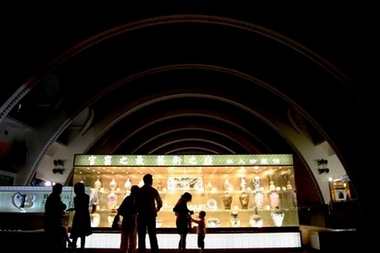Luxury fair targets China's new rich
(Reuters)Updated: 2007-06-03 15:30
SHANGHAI - Fancy a diamond-encrusted cellphone for $3.5 million, or a gold-plated, musical Swiss watch costing more than $2 million?
Hundreds of wealthy Chinese -- many of them dressed casually in sportswear or slippers, and indistinguishable from pedestrians on the streets outside -- crowded the exhibition hall, looking for ways to spend their money.
"The rich people here are still learning about global brands. We're helping them to understand the lifestyle and how to live it," said David Zhong, one of the organisers of the exhibition.
Concerned by social tensions caused by the widening gap between rich and poor, Chinese leaders are promising more policies to reduce income inequalities. Higher import duties were imposed this year on luxury goods from cosmetics to golf clubs.
But as the fair suggested, this is doing little to curb an explosion in luxury consumption that is making China one of the world's most important markets for purveyors of jewellery, fashionable clothing, expensive cars and beauty care products.
China had 250,000 US-dollar-millionaire households in 2005, ranking it sixth in the world, according to a study by the Boston Consulting Group. Its market for luxury goods was $6 billion in 2004, Goldman Sachs estimated. Both figures have grown rapidly.
"The Chinese luxury goods market is expanding with an annual rate of 10-20 percent. By the year 2015, China will become the second biggest luxury goods consumer market in the world next to the USA," Zhong said.
Over 150 international brands were on display at the fair. An entrance ticket cost 600 yuan ($80), a week's wages for many ordinary Shanghainese, while admission to a gala reception attended by film stars and tycoons from around the greater China region was by invitation only.
The contrast between China's past and present was underlined by the exhibition venue -- an ornate building, topped by a red star, which was built with Soviet help to commemorate the 10th anniversary of the communist party's civil war victory in 1949.
Not all the visitors were rich, and some were still too young to buy, further signs of the market's potential for long-term growth.
"We also have some guests who are pretty young, from 18 to 22. They do part-time jobs or just save for weeks to try our products," said Jin Yiyi, a manager for Helena Rubinstein cosmetics.
"They might only be able to afford our mascara at more than 300 yuan, but they cannot resist the attraction of the brand name."
A 13-year-old girl was impressed by a sleek Jaguar sports car on display. Her smiling mother said she had brought the girl to teach her about the fine things in life.
"It will help her to develop an elegant character at an early age," the mother said.
Jaguar sold 1,012 cars in China last year, up 58 percent from the previous year and double the pace of growth for the overall car market in China.
($1 = 7.64 yuan)
|
||
|
||
|
|

